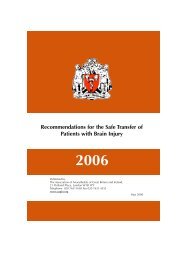TheatrePracticeStandardsGeneric1
Create successful ePaper yourself
Turn your PDF publications into a flip-book with our unique Google optimized e-Paper software.
Generic Theatre Standard No 06B - Management of Patients with CJD in<br />
the Operating Department<br />
Standard Statement: All Theatre staff will have knowledge of the requirements for caring for<br />
patients with Transmissible Spongiform Encephalopathy (TSE) Agents, Transmissible Creutzfelt-<br />
Jacob Disease (CJD) in the operating department to protect self, colleagues and patients from the<br />
risk of health care acquired infection: Safety and Infection Prevention<br />
The prevention of transmission of infection and the provision of safe instruments are fundamental<br />
for patient care. Incorrect procedures for the handling or processing of instruments used on<br />
patients infected with any form of Transmissible Spongiform Encephalopathy (TSE), namely<br />
Creutzfeldt-Jakob Disease (CJD) or Variant Creutzfeldt-Jakob Disease (vCJD) can present an<br />
infection risk to patients on whom instruments are subsequently used.<br />
General Considerations<br />
Please see: Policy for the Management of Patients who are symptomatic or at increased risk of<br />
Transmissible Creutzfelt-Jakob disease (CJD)<br />
Generic Theatre Standard 04 - Infection control in the Operating Department<br />
• Staff Available epidemiological evidence indicates that normal, social or routine clinical<br />
contact with a patient suffering from any type of CJD, including vCJD, does not present<br />
a risk to other patients, healthcare workers, relatives and the community. Although<br />
cases of CJD/vCJD have been reported in healthcare workers, there have been no<br />
confirmed cases linked to occupational exposure. The highest potential risk in the<br />
context of occupational exposure is from exposure to highly infective tissues through<br />
direct inoculation (e.g.: as a result of a sharps injuries, puncture wounds or<br />
contamination off broken skin) and exposure of the mucous membranes should also be<br />
avoided. Compliance with standard infection prevention and control precautions will<br />
minimise risks from occupational exposure. Though the risk remains low, where<br />
correction can be achieved by other means transfusion of blood and blood products<br />
should be avoided. Healthcare workers, who work with symptomatic patients with<br />
definite, probable or possible CJD or vCJD or with potentially infected tissues, should<br />
be appropriately informed about the nature of the risk and relevant safety procedures.<br />
o<br />
o<br />
Employers are required to keep a list of employees exposed to the agent of CJD of<br />
any type when there is a deliberate intention to work with the agent or, in cases if<br />
inoculation injury, if a risk assessment shows there is a significant risk. It is<br />
important to emphasise that a list is required where there is a likelihood of exposure,<br />
not simply when there has been a known incident or accident. This may include the<br />
scrub team in theatres. The lists will be kept by Occupational Health for 40 years<br />
after the last exposure. Some staff may need to be listed as being potentially<br />
exposed to CJD for example, neurosurgeons, laboratory and mortuary staff.<br />
Inform the Infection Prevention and Control team, theatre co-ordinator, Sterile<br />
Services Manager and appropriate laboratories.<br />
• Position on List, It is the responsibility of the patient’s Consultant to undertake a<br />
patient assessment and determine the patients risk group. The operative procedure<br />
should only be undertaken if there is no reasonable alternative. This is especially<br />
important where flexible endoscopes are involved, as there is no way of re-processing<br />
30





